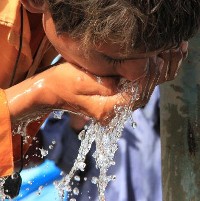25 January 2016
Pressure building on global water supply
If current trends continue, domestic and industrial water demand would more than double by the year 2050, and continue to increase after that, according to a new study published in the journal Geoscientific Model Development. The study introduces the first scenarios from the IIASA Water Futures and Solutions (WFaS) initiative, a multi-year interdisciplinary research project focusing on global water challenges and solutions, and explains the methodology and models used by the research initiative.
“Our current water use habits increase the risk of being unable to maintain sustainable food production and economic development for the future generation,” said IIASA water program researcher Yoshihide Wada, also a researcher at Utrecht University in the Netherlands. “We need strong social, financial, and political commitments to reduce future water use.”
Estimating future water use is challenging because it is influenced by many factors, including population growth, economic growth, climate change, agriculture, energy production, and local, regional, and international policy.
The WFaS initiative, launched in 2012, combines multiple models with input from water managers and other experts on local and global water issues. It is the first multi-model analysis of 21st century water use, and is designed to be consistent with climate projections published in the latest report from the Intergovernmental Panel on Climate Change (IPCC).
Wada says, “Our multi-model framework also provides a possible range of future water use. This can be used to develop different types of management and policy options that are needed to understand the extent of water resource challenges faced around the world.”
Global maps of projected domestic water withdrawals calculated by the global water models H08, PCR GLOBWB, andWaterGAP for the years 2010 and 2050, respectively, under the SSP2 scenario. Avr, Std, and Std/Avr denote average, standard deviation, and coefficient of variations (CV). (Credit: Wada et al 2016)
The new study provides an overview of different approaches assessing water demand, and the uncertainty, strengths, and weaknesses of the various estimation methods. It reviews the models currently in use to understand water use across all sectors, and explains the methodology and models used in the WFaS initiative.
Wada says, “If we invest more to improve water use efficiency and water saving, we could substantially reduce and potentially stabilize future water use by 2050.”
Reference
Wada, Y., Flörke, M., Hanasaki, N., Eisner, S., Fischer, G., Tramberend, S., Satoh, Y., van Vliet, M. T. H., Yillia, P., Ringler, C., Burek, P., and Wiberg, D.: Modeling global water use for the 21st century: the Water Futures and Solutions (WFaS) initiative and its approaches, Geosci. Model Dev., 9, 175-222, doi:10.5194/gmd-9-175-2016, 2016. http://www.geosci-model-dev-discuss.net/gmd-2015-144/

Water Futures and Solutions
A groundbreaking study into sustainable solutions to meet local, national, and global water challenges
MULTIMEDIA
09 February 2016
Bill Cosgrove


